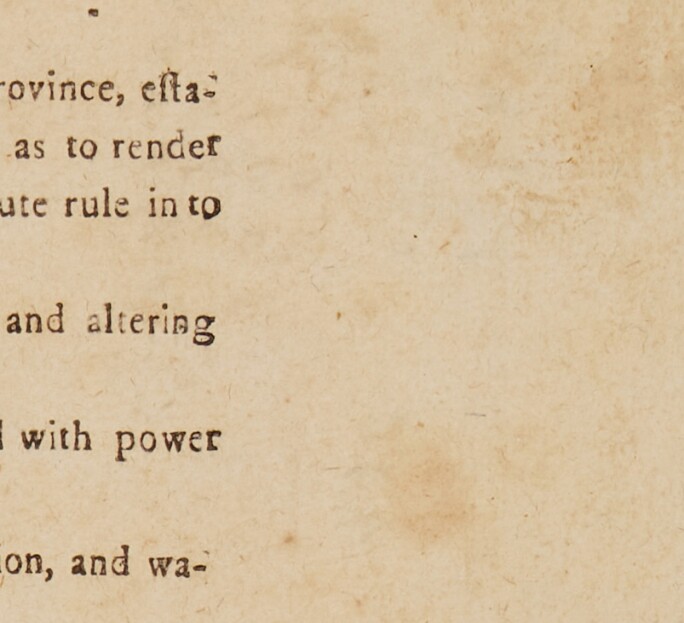"We hold these truths to be self-evident, that all men are created equal, that they are endowed by their Creator with certain unalienable rights, that among these are Life, Liberty, and the Pursuit of Happiness."
The document that gave rise to the United States, and the embodiment of American innovation.

Thomas Jefferson called it “an expression of the American mind.” Approved on 4 July 1776 after three days of debate, the Declaration of Independence was swiftly printed by John Dunlap, Congress’s official printer.
Dunlap’s broadside spread through the thirteen colonies, where local printers hastened to create their own versions to meet the public’s demand for evidence of independence. This rare broadside, printed by Robert Luist Fowle in Exeter, New Hampshire, in July 1776, is one of just ten known copies, with only two others sold at auction in the past century. It carries the distinguished Goodspeed-Sang-Streeter provenance.
- May 1776
- 7 June 1776
- 11 June 1776
- 12 June 1776
- 4 July 1776
- 5 July 1776
- 6 July 1776
- 16 July 1776
- July–August 1776
- January 1777
-
 May 1776Continuing debates in the Continental Congress reveal division over pursuing independence. John Dickinson leads a coalition advocating reconciliation with Britain.
May 1776Continuing debates in the Continental Congress reveal division over pursuing independence. John Dickinson leads a coalition advocating reconciliation with Britain. -
 7 June 1776Richard Henry Lee introduces a resolution declaring the colonies free and independent states, sparking sharp debate.
7 June 1776Richard Henry Lee introduces a resolution declaring the colonies free and independent states, sparking sharp debate. -
 11 June 1776A committee of five (Thomas Jefferson, John Adams, Benjamin Franklin, Roger Sherman, and Robert R. Livingston) is appointed to draft the Declaration of Independence.
11 June 1776A committee of five (Thomas Jefferson, John Adams, Benjamin Franklin, Roger Sherman, and Robert R. Livingston) is appointed to draft the Declaration of Independence. -
 12 June 1776Virginia adopts George Mason’s Bill of Rights, a document that influenced Jefferson's drafting of the Declaration.
12 June 1776Virginia adopts George Mason’s Bill of Rights, a document that influenced Jefferson's drafting of the Declaration. -
 4 July 1776The Continental Congress approves the Declaration of Independence after three days of debate. That evening, John Dunlap prints the first broadsides in Philadelphia.
4 July 1776The Continental Congress approves the Declaration of Independence after three days of debate. That evening, John Dunlap prints the first broadsides in Philadelphia. -
 5 July 1776Distribution of the Dunlap broadside begins with copies being sent to the states and commanding officers of the Continental Army.
5 July 1776Distribution of the Dunlap broadside begins with copies being sent to the states and commanding officers of the Continental Army. -
 6 July 1776The July 6, 1776 issue of the Pennsylvania Evening Post presented the first newspaper printing of the newly adopted Declaration of Independence.
6 July 1776The July 6, 1776 issue of the Pennsylvania Evening Post presented the first newspaper printing of the newly adopted Declaration of Independence. -
 16 July 1776The Declaration appears in Robert Luist Fowle’s New Hampshire Gazette, likely using a Dunlap broadside as the copy text.
16 July 1776The Declaration appears in Robert Luist Fowle’s New Hampshire Gazette, likely using a Dunlap broadside as the copy text. -
 July–August 1776Thirteen broadside editions of the Declaration are printed across six states, with additional versions appearing in newspapers.
July–August 1776Thirteen broadside editions of the Declaration are printed across six states, with additional versions appearing in newspapers. -
 January 1777Congress, now sitting in Baltimore, commissions a second official broadside to preserve the Declaration's memory, transmitting copies to state governments. Printed by Mary Katharine Goddard, this is the first broadside to include the names of the Signers of the Declaration and not just those of the president and secretary of Congress.
January 1777Congress, now sitting in Baltimore, commissions a second official broadside to preserve the Declaration's memory, transmitting copies to state governments. Printed by Mary Katharine Goddard, this is the first broadside to include the names of the Signers of the Declaration and not just those of the president and secretary of Congress.

- John Hancock’s signature

Unlike the engrossed Declaration now in the National Archives, only the names of John Hancock and Charles Thomson, respectively president and secretary of Congress, appear on the 1776 broadsides of the Declaration
- 4 July 1776

The official date of adoption by the Continental Congress
- Two columns of text

This Essex printing is one of seven of the thirteen contemporary broadsides to have the Declaration set in two columns
- "When in the course of human events..."

The introduction to the Declaration articulates Enlightenment ideals of natural rights and social contract theory, establishing the philosophical foundation for independence
- “The history of the present King of Great Britain…”

This section enumerates specific grievances against King George III
- Jefferson’s missing condemnation of the slave trade

Jefferson’s original draft included a condemnation of the transatlantic slave trade. Its removal, driven by political compromise, sought to ensure the agreement of the Southern states to the cause
















